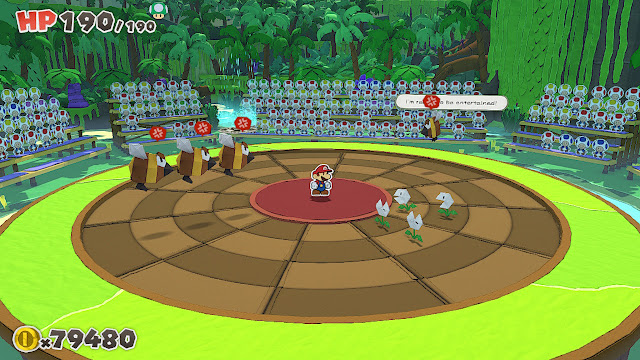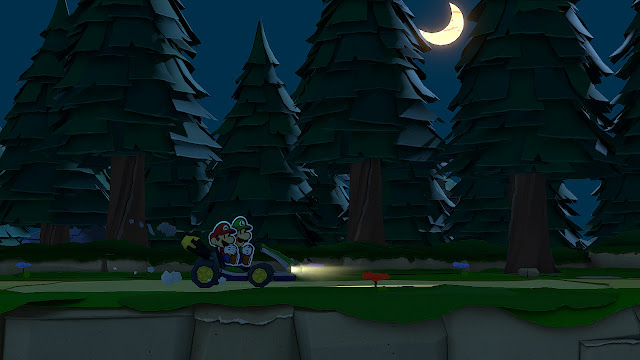It’s not a great game, but
Animal Crossing: Amiibo Festival is a fixture in my home. I actually expect at this point that we’ve played more of that game than pretty much anybody else. To be honest, it’s not a great game, but it has some interesting points and it’s a game I’ve spent a long, looong time
thinking about.
 |
| Welcome |
I’d usually offer spoiler warnings at this point, but I’m not sure there really are spoilers for a party game like this. Additionally if there are spoilers, they’re for Animal Crossing in general or for Animal Crossing: New Leaf more specifically.
Things I Liked
I’m relatively new to Animal Crossing. I only picked up the series at New Leaf (the 4th game in the series, which came out in 2012). I picked it up after watching
Chuggaconroy’s Animal Crossing: New Leaf Let’s Play. I bought matching 3DSs for my partner and I and two copies of
Animal Crossing New Leaf. We got up extremely early on Boxing Day to watch the World Junior Hockey Championship, and started two new towns. I played New Leaf for well over a year, but eventually petered out as the new things to see in the game became fewer and fewer. My partner still plays at least a little bit each day (even with New Horizons to play as well).
 |
| The tradition keeps it going for us. |
The town itself is an important part of any Animal Crossing game. Which
villagers are in town, how the town is laid out, how the town is decorated are all important aspects. The town in Animal Crossing: Amiibo Festival is also important. The game is played on a map of spaces spread out around a randomly generated town when you start playing. The different spaces in the game map to different events based on local fixtures so as you move around the map you get a few different experiences based on where you are. This provides a lot of familiarity as you swing by the coffee shop, or the bonfire, or the pool.
Events happen each time you land on a space. Each time you stop, a tiny vignette plays out with your character getting happier or making money, or getting sadder or losing money. The generic events are alright, but they don’t really hold the game in the long term. The events based on places around town are a nice addition, especially as your town grows, but the events that happen especially for specific characters have been the things that really charmed us. Having Blathers find fossils for the museum or Reese spend the day working with Cyrus makes the game charming and different enough each time you play it to keep it interesting. The special monthly events, like Festival, Toy Day or the August fireworks are also important and charming. We made a rule early on that we’d only play in the current month and that means that the time passing in real life is an important part of our enjoyment of the game.
The
Amiibo Figures are also a nice part of Amiibo Festival. Getting to bring in villagers to live in the town (and host the games) is nice. Playing the game as the special villagers (such as
Isabelle,
Digby, etc…) is nice. The events provide them with a lot of character on top of whatever you bring in from other animal crossing games and the variety of costumes makes it worthwhile to keep playing.
 |
| I've had a K.K. concert running in my living room for the last three years. |
Things I didn’t Like
While it has charm, Animal Crossing: Amiibo Festival seriously lacks things to do (let alone interesting decisions). It's probably worth noting, that my perspective is as someone who is not a kid and does not have kids, so my expectations are different than the developers. Still I feel like there are some elements of this game which aren't as good as they could be. The basic mechanic has you rolling a D6 to move around the board. When you reach a branch in the path, you can choose which direction you want to go. On top of that you can collect cards that let you go a specific number of spaces, do something special, like roll double or pick your roll, or change a few other aspects of the game.
 |
| Roll and find your fate. |
The frustrating part is that there’s enough flexibility in what they designed that you could make interesting choices once a turn, or at least once every few turns.
I see that they want to have a heavy randomness in the game. The game has a strong “Snakes and Ladders” or “Candyland” flavour, in that your success in life is at the hand of bigger elements. Similarly, randomness is a staple of Mario Party, and it makes it easier for people of different skill levels to play together. However. I think they could have kept a lot of that randomness while still allowing the player to do a little more to control their own fate. A weekly card, along with the weekly turnips, would have gone a long way towards making this work. Or maybe a no-items, final destination configuration might also help for some long-term players.
 |
| Happiness in August |
One of the other things that is somewhat frustrating about the game is that there’s no trade off between the two currencies in the game. You have bells (money) and you have happy points (happy … points). Sometimes you get events which give you both, just one, take one away or take both away. I have certainly traded happiness for money in my life and money for happiness, so it’s a little disappointing sometimes that the game has no trade-off option between the two. Especially as there are lots of in game events which seem like this would be the appropriate result. I spent a little extra money on my coffee today, and I really enjoyed it, is a “you lost money” event, rather than a “you lost money, but got happy” event.
The final thing that particularly frustrates me that I’d like to include here is that the game just stops. Well that’s not strictly true, so far as we’ve played the game continues, with different events each month, but the ability to grow your amiibo cuts off after level 6. I suppose that’s fair enough, but it feels to me a bit as though they didn’t have a lot of plans for people to play the game as long as we’ve played it.
Things I Noticed
The strength of Amiibo Fest is really in its charm. We’ve tried to play it a bit slowly, adding new things to the town infrequently and we’ve limited the number of animals we’ve added to the town too (which is partly due to a lack of the animals we want on the Amiibo Cards we were able to find).
 |
| Llama love is in the air. |
Still despite the fact that this is a candy land style game, with a, you take the good with the bad and everything balances out mindset, we’ve managed to play about once a week for more than two years now. While that certainly says something about us, I think it also speaks to the way the game feels.
Obviously the Animal Crossing games in general are a testament to the idea that you can have many different
verbs in gaming and that non-combative ones can be just as appealing. Amiibo Festival feels like a part of that dialogue, a game which focuses on togetherness beyond the game.
Things I’d Include in a Game
I have a lot of feelings about Amiibo Fest, but I don’t know that I want to, or could, create a game that follows it’s structure or design. That being said, I think the persistent environment of a board game that grows over time is very nice, especially if it can be managed in such a way that it has a narrative arc with an ending to it. Pandemic Legacy is a great game that you can play over many sessions and you build up a world with your history of mistakes and successes. I think having a gentler game that still builds up its own history as you play it is an interesting approach.
 |
| Remember Last Year? |
I also think you could expand that to have a game grow over the course of a year and then have a giant celebration leading into a new game plus, new year kind of thing. That way you could have a new town grow up to follow your old towns each year, with some elements of the old towns kept around for nostalgia or remembrance and then new elements from your new town for the new year.
I was pretty flabbergasted when I saw The Runaway Guys tackle this and realized they were playing in a totally different town, and I think this game might have benefitted from making that difference a little more palpable. Obviously not everyone is going to want to step away from the town they have, but having a natural end might make it easier to decide when and how to end.
Final Things
I don’t know if Amiibo Festival could have been better. I won’t argue that the charm is reason enough to play, and if you’re looking for anything like a Mario Party experience you’re going to be disappointed. As I said, this is very much a Candyland experience. That being said, we still enjoy it and every time I play I'm struck that with just a little different construction it could have been a secret gem that really lasts.
 |
| I mean, how much charm can this game have? |
































